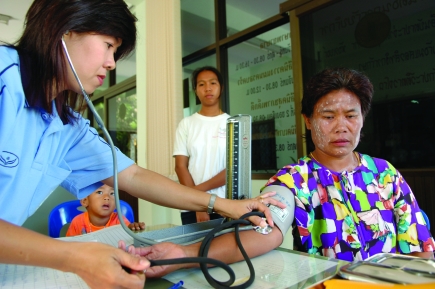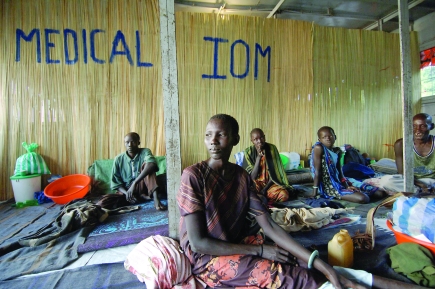Abstract
With increasing numbers of people on the move, migrant health has become a key global public-health issue. Alice Ghent reports.
Climate change, global conflict and economic necessity are driving the highest levels of migration in history. According to the International Organization for Migration (IOM) some 192 million people are living outside their place of birth, representing about 3% of the world’s population.
The sheer scale of human displacement has turned migrant health into a priority global public-health issue, an issue rendered more complex by the diversity of the populations involved – from people in search of work or education to more vulnerable groups like asylum seekers and refugees.
Apart from the increased potential for the spread of infectious disease that a more mobile global population brings, there is also rising concern that migrants’ health needs are not always adequately met. Many countries restrict access to health care for certain migrant groups – including irregular migrants and asylum seekers. For example, until a recent court ruling, the United Kingdom restricted access to free health care to some migrants – including irregular migrants – to counter any possibility that they were entering the country primarily for free medical treatment.
Dr Daniel López-Acuña, director of WHO’s Health Action in Crises Recovery and Transition Programmes, says migrant health issues are “now coming to a head in some countries, which is why they have been raised at the highest levels within the public-health agenda at national and international health levels”.
For López-Acuña, the threat of communicable diseases spreading is only one aspect of the issue: “With ever-increasing migrant populations in many countries, more strain is being put on government systems that provide health services to the public,” he says. This strain is even greater when the flow of humanity is between lower-income countries, says Dr Eric Laroche, assistant director-general of the Health Action in Crises cluster of departments at the World Health Organization (WHO). “Providing health care for new flows of migrants can place extra burdens on the receiving country,” he says, and cites poverty, marginality and the stress of displacement among the factors affecting the health of populations on the move.
At the World Health Assembly in May, WHO agreed on four strategies to address the vulnerabilities and health-care needs of migrants.
“Advocacy and policy development is crucial to ensure migrants have equitable access to health services,” says López-Acuña. “There is also a need to assess trends in migrants’ health by improving country health information systems, which can help identify and fill gaps in service delivery.” López-Acuña also believes it is essential to train policy-makers and health stakeholders on migrant health issues, and to improve service delivery to reinforce migrant-friendly public-health services and establish minimum health-care standards for all vulnerable migrant groups.
Between 1960 and 2005 the number of international migrants in the world more than doubled, from an estimated 75 million in 1960 to almost 191 million in 2005, according to a United Nations report, Trends in total migrant stock, 2005 revision. Migration is now running at about 3% annually, according to the IOM. Undocumented migration is harder to track but the International Labour Organization estimates that there are 15–30 million irregular immigrants internationally.
Refugees represent 9.7% of global migrants, according to the World refugee survey in 2005, which estimated that there were 17 million global refugees, most of whom were hosted by African countries.
Family reunification and the allure of a better life, including enhanced prospects for work or education are driving migration to countries belonging to the Organisation for Economic Co-operation and Development (OECD). From 2004 to 2005 immigration to OECD countries increased by four million people. This labour-driven trend is expected to continue as high-income countries with low fertility see their populations decline and age.
According to Sally Hargreaves, an expert in migrant health at Imperial College, London, the implications of rising rates of immigration for health services are poorly understood. She says health-care provision for the many different migrant groups varies widely from country to country.
Other commentators too have noted that in the Netherlands, for example, migrant health has been the subject of sustained and systematic attention since 2000, while Italy has been setting migrant-related health policy targets since the 1990s. Spain on the other hand has only recently started to include migrant health and health-care issues in national and regional plans for the integration of immigrants.
In some countries migrants find themselves completely excluded from routine health services. “What is increasingly being documented too is that vulnerable migrants – whether entitled to free health care or not – face numerous barriers to accessing an appropriate level of health care, and this has implications for both individual and public health, as well as for health-care providers,” Hargreaves says.
Hargreaves believes there is a “real need to explore and document models of best practice in the developed-world context for delivering services to various migrant groups, and their impact on health outcomes.” She also considers defining a new research and policy agenda for migrant health to be “an urgent priority”. As an example of policy under strain, Hargreaves cites criticism of the United Kingdom screening new migrants arriving through its airports for tuberculosis. Critics have said resources could be used more effectively by improving community-based tuberculosis screening programmes that encompass a wider range of health-care issues.
Perhaps, not surprisingly, among the governments that have worked hard to address health care for migrants are those most familiar with the challenges. Australia, for example, with nearly a quarter of its population (5.3 million) born overseas, has a long experience in the delivery of specialized health-care services for migrants.
Responsibility for health is split between the states and the federal government. The states have their own variations of migrant care but the system recognizes that not all migrants are the same. In the state of Victoria, for example, migrants can access a range of health services through Community Health Centres or general practice surgeries, while there is also a specialized service for refugees who may have special needs due to torture or hardship brought about by war and dislocation.
Australia admits 13 500 refugees a year. On arrival refugees are entitled to a free medical assessment. However, asylum seekers face greater barriers to accessing medical care. Many are not eligible for free medical treatment under the national insurance scheme called Medicare and have to seek services offered for free. This situation has been remedied at least partly in the state of Victoria, through access to hospital-based care and several other state-funded services.
Demos Krouskos is the director of the Melbourne-based Centre for Culture, Ethnicity and Health, which Victoria set up in 1993 to advise health-care institutions on how to improve access to health services for culturally diverse communities. “There was recognition that migrant-health services needed to become socially and culturally inclusive,” he says.
“In order to achieve this, institutions have to be reformed on a philosophy of social inclusion – that it is a human right to have equal access to health-care services. Health-care institutions are the last great institutions to be unreconstructed in this area,” he says, adding: “You can have discrimination simply by failing to include people.”
Instead of focusing on the needs of specific migrants, the emphasis is on making health care accessible to everyone. Staff should not make assumptions, he says. “The woman from Iraq may not be Muslim. We urge people to learn about the individual in their office. They must reflect on their values and ask are they treating people fairly?” ■
Migrant community health worker provides health assistance in Thailand, in 2006.
© Thierry Falise/IOM 2006
Migrants on a medical barge displaced by conflict in the Sudan, in 2006.
© Sven Torfinn/IOM 2006




